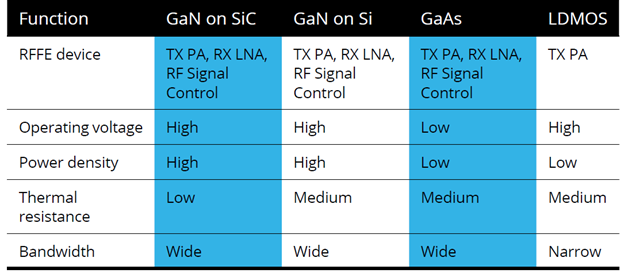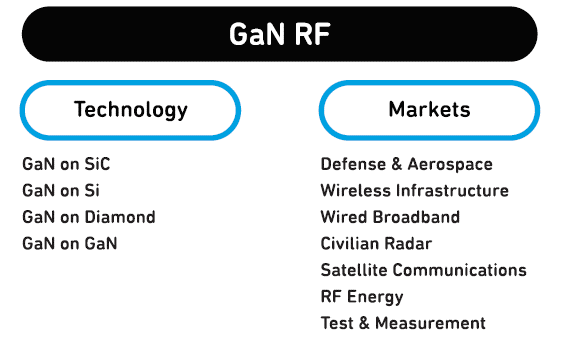What You Need to Know About GaN Technology
February 15, 2023
Thanks to just a couple of elements on the periodic table, engineering may never be the same. There. We said it. But the fact is that after the introduction of gallium nitride (GaN) transistors, first demonstrated in the 1990s, RF engineering hasn't been the same and is changing by the day.
GaN stands out thanks to its high-current, high-voltage capabilities that enable it to be versatile enough for a wide range of demanding applications, as shown in Table 1-1 below. Its unique material properties make it the new go-to technology in everything from 5G communications to automotive, lighting, radar, satellites and more. And because of its abilities, developers aren't stopping there. They're continuing to push the envelope and further revolutionize the technology to allow new, higher-demand applications for the future.

Table 1-1: High-current, High-voltage capabilities of GaN manufacturing processes enable a wide range of demanding applications.
GaN offers designers a competitive advantage when developing systems that require high power, wide bandwidth, high operating voltage and high thermal capabilities. These days, many engineers are predicting that GaN could eventually replace technologies such as laterally diffused metal-oxide semiconductors (LDMOS) in many applications. The evidence is compelling. GaN readily enables existing and new applications. It has proven easy to use, provides plug-and-play replacement and is as reliable as current technologies, if not more so.
For new applications like 5G, GaN already meets all these prerequisites for replacing the existing technologies. GaN in 5G supports faster data speeds, increased RF range, increased temperature robustness, high input power level robustness, smaller sizes and more efficient power consumption. GaN's RF system benefits stem from its unique material properties of wide bandgap, high-charge density, high-electron mobility and high-temperature tolerance. All of this allows the RF benefits of high power added efficiency (PAE), high power output, small form factor, wide bandwidth and ruggedness. GaN enables systems to run with lower operating current and cost. System designers can design systems with fewer components. That shortens design time and lets products get to market faster. In addition to its high thermal conductivity, GaN is known for its low sensitivity to radiation. If you take a look at Table 1-1, you'll see that GaN manufacturing processes mostly use silicon carbide or silicon substrates (GaN on SiC and GaN on Si, respectively). Each substrate has its advantages. Silicon is relatively inexpensive compared to silicon carbide. But in many aspects, GaN on SiC offers more significant benefits compared to GaN on Si, thanks to its higher reliability and power. This makes GaN on SiC the best option for many applications in 5G telecom, defense, aerospace and more.
Learn about GaN basics
Qorvo's 2nd Special Edition of GaN Technology For Dummies offers a basic but actionable introduction to GaN technology and the forces behind its application growth, namely, its wide range of benefits. GaN has taken over in areas where other materials had been long-established as the standard. For instance, silicon technologies like LDMOS. GaN's ability to complement GaAs is driving GaN's use in both commercial and defense applications. GaN is also helping to improve system performance where some applications struggle to meet the higher power, frequency and efficiency requirements of next-generation communications systems.
So, with all this in mind, this book will help you:
- Understand GaN's unique material properties
- Learn how GaN is being used in important radar applications
- Discover how GaN is used in commercial, retail and space applications
- Learn the best GaN process technology for your own applications
- Understand how GaN is advancing today's markets as well as the future
GaN: Then and now
GaN's potential as a high-power and high-frequency semiconductor transistor-based material was first recognized and explored in the early 1990s. By the mid to late 2000s, GaN had made its way into production applications for defense and aerospace and commercially in light-emitting diodes (LEDs) for solid-state lighting. Since then, GaN has seen increased acceptance in radio frequency (RF) electronics and widespread adoption in commercial wireless applications, including 5G. RF adoption has been aided by GaN material advances that enable the creation of superior high-power-density, high-efficiency RF amplifiers.
Many semiconductor market analysts still describe GaN as a relatively new technology. But in just a few years, GaN has already jumped from newcomer to frontrunner in many applications. GaN is not only replacing entrenched silicon technologies like LDMOS, but it's also helping to boost overall system performance when used alongside other technologies like GaAs.
GaN's ability to complement established technologies like GaAs is helping accelerate its adoption in both defense and commercial applications. GaN is also helping to improve system performance in applications struggling to meet next-generation systems' upper power, frequency and efficiency requirements. It is, therefore, becoming the go-to technology for new wider bandwidth, higher-frequency RF applications.
So, how about a head start on the future?
GaN had its debut many years ago in military and aerospace applications. But since then, it has been used in many commercial applications like wireless infrastructure, CATV, space, scientific and others, as shown in Figure 1 below.

Figure 1: GaN RF technologies and markets
GaN technology will continue to advance in the coming years, and so will its popularity in newer and more sophisticated applications. Demand for use in military radar, electronic warfare and communication systems may be the growth drivers now. Still, a wide range of other innovative applications are on the horizon thanks to GaN's material properties. Consider these:
Data centers
Data centers are expanding due to the massive growth in cloud computing. These data centers consume huge amounts of energy, so reducing energy consumption is a priority.
Automotive
Electric vehicles (EVs) use GaN DC power transistors. Combining more power-dense batteries, efficient motors and onboard chargers helps trim vehicle weight, which boosts range.
Wireless charging
Wireless charging isn't just for smartphones anymore. It's becoming more common in our homes. You'll also find wireless charging integrated into automobiles and medical devices. All these applications demand GaN transistors.
Power supply adapters
DC power supply design advances keep improving, but established silicon switch technology is reaching its physical limits. GaN DC power transistors can turn on faster than silicon, reduce losses and increase switching speeds. Manufacturers are now looking to GaN for size reduction, better efficiency and increases in power.
Medical
You'll find GaN migrating into X-ray and magnetic resonance imaging (MRI) machines. Using GaN helps reduce size in MRI applications. Additionally, using GaN in MRI machines increases image resolution to 10 to 100 times better than non-GaN machines. That means medical professionals can spot cancers and other diseases earlier, more accurately and at less expense. High-energy RF is also used in radio frequency ablation (RFA) equipment for treating malignant tumors.
Wireless handsets
GaN has been used in military electronic warfare (EW) handheld radios for years thanks to the power, high frequency, wide bandwidth and reliability needed in harsh environments. Today, commercial telecommunications carriers need to meet similar demands for their handsets.
Scientific applications
Scientific researchers need greater capabilities in 5G test and measurement. For example, you'll find GaN in devices supporting particle accelerators and chemical vapor deposition (CVD) systems. CVD produces high-quality solid thin films and coatings and offers advantages over evaporation and sputtering methods using physical vapor deposition. GaN deployed in electromagnetic compatibility (EMC) test equipment provides the high power and wide bandwidth needed for qualifying 5G products.
Space applications
Space applications are dependent on size and weight. This puts GaN's low power consumption, small size, high reliability and radiation tolerance in high demand. Other technologies require special radiation shielding, but GaN is naturally immune to radiation.
Key Takeaways
The book also includes its own synopsis of topics for quick reference so you can pick a subject and dig deeper into the appropriate chapter. For instance:
- Gallium nitride (GaN) is a high-performance compound semiconductor. Compound semiconductors offer a superior combination of speed and power.
- GaN offers unique benefits. GaN's unique material properties provide high power added efficiency (PAE), high power output, small form factor, wide bandwidth, thermal advantages and durability.
- Commercial, defense and space systems use GaN. GaN's unique advantages support new and existing applications, including radar, satellite communications, commercial wireless networks and cable TV.
- GaN is critical for 5G. 5G requirements demand multi-gigabit speeds and ultra-low latency. As a result, equipment manufacturers deploy high-power GaN in massive multiple input, multiple output (MIMO) systems.
- GaN is extremely reliable, even in harsh environments.
- GaN is available for high-volume production applications. The U.S. Department of Defense classifies GaN at the highest maturity and manufacturing readiness level (MRL), MRL 10. That means full-rate production and lean production practices are in place.
- GaN is expanding into new markets. Its unique properties allow GaN technology to spread into new areas, including automotive, medical systems and advanced scientific applications.
GaN Future
Innovations in GaN technology and packaging in the future will support higher frequencies, higher voltage and even wider bandwidth, further fueling GaN adoption. Look for more innovations and expertise from Qorvo.
Have another topic that you would like Qorvo experts to cover? Email your suggestions to the Qorvo Blog team and it could be featured in an upcoming post. Please include your contact information in the body of the email.

